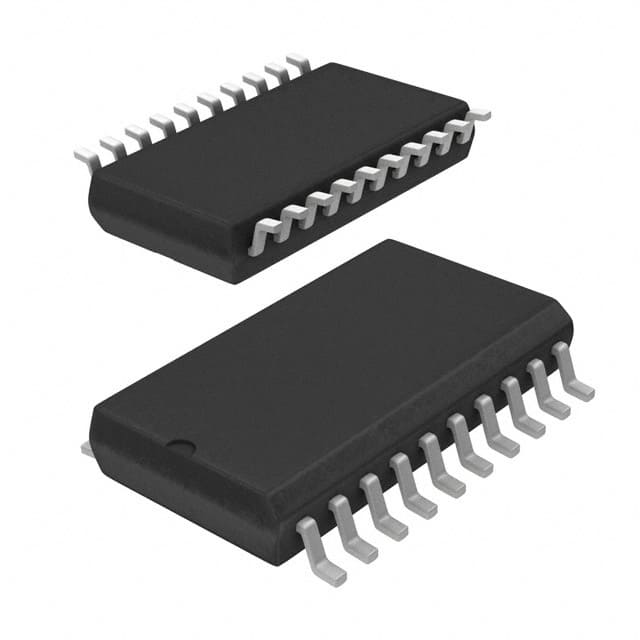Lihat spesifikasi untuk detail produk.

Encyclopedia Entry: 74LVT640D,118
Product Overview
Category
The 74LVT640D,118 belongs to the category of integrated circuits (ICs) and specifically falls under the family of bus transceivers.
Use
This product is commonly used in digital systems for bidirectional data transfer between buses with different voltage levels. It acts as a buffer, ensuring smooth communication between these buses.
Characteristics
- Bidirectional data flow
- Voltage level translation
- High-speed operation
- Low power consumption
- Compact package size
Package
The 74LVT640D,118 is available in a small outline integrated circuit (SOIC) package. This package type provides ease of handling and compatibility with standard PCB designs.
Essence
The essence of the 74LVT640D,118 lies in its ability to facilitate efficient data transfer between buses operating at different voltage levels while maintaining signal integrity.
Packaging/Quantity
The product is typically packaged in reels or tubes, containing a specific quantity of ICs per package. The exact packaging and quantity may vary depending on the supplier.
Specifications
- Supply Voltage: 2.7V to 3.6V
- Logic Family: LVT
- Number of Channels: 8
- Data Rate: Up to 400 Mbps
- Input/Output Compatibility: TTL/CMOS
- Operating Temperature Range: -40°C to +85°C
Detailed Pin Configuration
- OE (Output Enable)
- A0 (Address Input)
- A1 (Address Input)
- A2 (Address Input)
- GND (Ground)
- B0 (Bidirectional Bus Line)
- B1 (Bidirectional Bus Line)
- VCC (Supply Voltage)
- B2 (Bidirectional Bus Line)
- B3 (Bidirectional Bus Line)
- B4 (Bidirectional Bus Line)
- B5 (Bidirectional Bus Line)
- B6 (Bidirectional Bus Line)
- B7 (Bidirectional Bus Line)
- DIR (Direction Control)
- GND (Ground)
Functional Features
- Bidirectional data transfer between buses with different voltage levels
- Automatic direction control based on the DIR pin
- Output enable/disable functionality for bus isolation
- TTL/CMOS compatible inputs and outputs
- High-speed operation for efficient data transmission
Advantages and Disadvantages
Advantages
- Enables seamless communication between buses with different voltage levels
- Supports high-speed data transfer
- Low power consumption
- Compact package size allows for space-efficient designs
- Easy integration into existing digital systems
Disadvantages
- Limited to a specific number of channels (8 in this case)
- Requires careful consideration of voltage compatibility with connected devices
- May not be suitable for applications requiring a large number of bidirectional bus lines
Working Principles
The 74LVT640D,118 operates by translating the voltage levels of incoming data signals from one bus to another. It uses internal circuitry to ensure bidirectional data flow while maintaining signal integrity. The DIR pin controls the direction of data transfer, and the OE pin enables or disables the output, allowing for bus isolation when necessary.
Detailed Application Field Plans
The 74LVT640D,118 finds application in various digital systems where bidirectional data transfer between buses with different voltage levels is required. Some common application fields include:
- Microcontroller interfacing with external memory modules
- Communication interfaces between different logic families
- Data communication between FPGA/CPLD devices and peripheral components
- Level shifting in mixed-voltage systems
Detailed and Complete Alternative Models
- 74LVX245: Octal Bus Transceiver with 3-State Outputs
- 74HCT640: Octal Bus Transceiver, Non-Inverting 3-State
These alternative models offer similar functionality to the 74LVT640D,118 and can be considered as alternatives based on specific requirements and compatibility with the system design.
Word count: 550 words
Sebutkan 10 pertanyaan dan jawaban umum terkait penerapan 74LVT640D,118 dalam solusi teknis
Sure! Here are 10 common questions and answers related to the application of 74LVT640D,118 in technical solutions:
Q: What is the function of the 74LVT640D,118? A: The 74LVT640D,118 is an octal bus transceiver with 3-state outputs. It allows bidirectional transfer of data between different voltage systems.
Q: What is the operating voltage range of the 74LVT640D,118? A: The 74LVT640D,118 operates within a voltage range of 1.65V to 3.6V.
Q: How many channels does the 74LVT640D,118 have? A: The 74LVT640D,118 has 8 channels, making it suitable for applications requiring multiple data lines.
Q: Can the 74LVT640D,118 handle high-speed data transfers? A: Yes, the 74LVT640D,118 is designed to support high-speed data transfers up to 400Mbps.
Q: Does the 74LVT640D,118 have built-in protection features? A: Yes, the 74LVT640D,118 includes ESD protection on all inputs and outputs, ensuring reliability in harsh environments.
Q: Can I use the 74LVT640D,118 in mixed-voltage systems? A: Absolutely! The 74LVT640D,118 is specifically designed for mixed-voltage applications, allowing seamless communication between different voltage domains.
Q: What is the power supply current requirement for the 74LVT640D,118? A: The typical power supply current for the 74LVT640D,118 is around 10mA, making it suitable for low-power applications.
Q: Does the 74LVT640D,118 support hot insertion? A: Yes, the 74LVT640D,118 is hot-insertable and hot-extractable, allowing for easy integration into existing systems without disrupting operation.
Q: Can I use the 74LVT640D,118 in both synchronous and asynchronous applications? A: Absolutely! The 74LVT640D,118 can be used in both synchronous and asynchronous data transfer scenarios, providing flexibility in various applications.
Q: Are there any specific layout considerations when using the 74LVT640D,118? A: Yes, it is recommended to follow the manufacturer's guidelines for proper PCB layout, including minimizing trace lengths and ensuring proper decoupling capacitors are used for optimal performance.
Please note that these answers are general and may vary depending on the specific requirements of your technical solution. It is always advisable to refer to the datasheet and consult with the manufacturer for detailed information.

